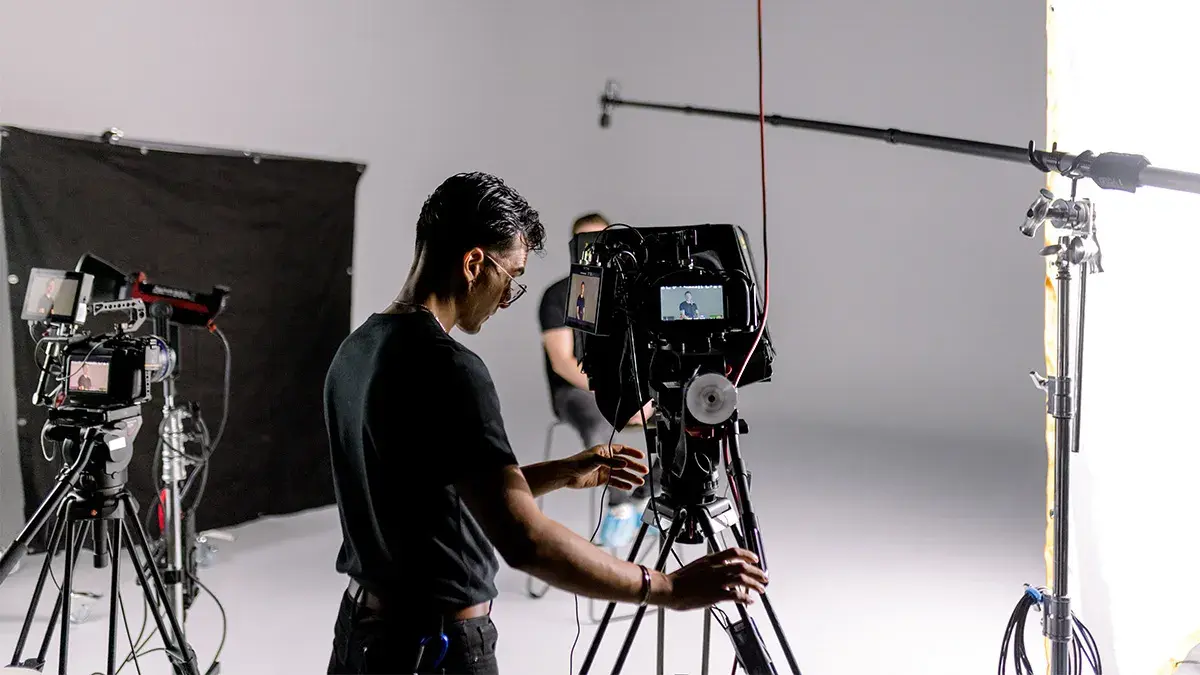How to Create a Promo Video: A Step-by-Step Guide for Businesses
Promotional videos can raise awareness for your brand, support product launches, and directly contribute to your return on investment (ROI). Best of...
▶ Video Strategy & Discovery
A video marketing strategy will keep your production cohesive and on schedule.
▶ Creative Treatments, Scripts & Storyboards
Bring your vision to life with professional scriptwriting and storyboarding services.
▶ Production Preparation
Prepare for your corporate video with professional video production services.
▶ Full Service Filming Days
Discover how Charter & Co can help you bring your vision to life through expert on-set filming services.
▶ Video Editing, Color Grading & Sound Design
Elevate your video marketing with Charter & Co’s expert video editing and post-production services.
▶ Motion Graphics
Captivate audiences with videos, ads, and social media that include high-quality animations.
▶ Licensed Music & Voiceovers
Elevate your videos with high-quality music licensing and voiceover services.
▶ Distribution Strategy & Advertising Support
Get your content noticed with a comprehensive video distribution strategy.
▶ Everything Video Marketing
Video marketing resources: What it is, why it matters, and how to do it.
▶ Everything Video Production
Your ultimate guide to video production resources: Tips and tricks for creating masterful videos.
▶ Blog
Helpful Blog resources for all of your video production and marketing needs.

As social media like TikTok continues to rise in popularity, video marketing has become an incredibly valuable tool for marketers. If crafted the right way, a video can reel in potential customers and offer a high return on investment (ROI).
However, creating the perfect corporate video marketing strategy takes strategic planning. You need to understand who your audience is, what they crave, and where they hang out. We’ve got your guide to creating an effective video marketing strategy below.
There are several steps you’ll need to take to craft an effective video marketing strategy that catches the attention of potential customers. Every marketing strategy has a goal, and that goal will be the driving force of your marketing strategy. Your goals should follow the SMART acronym: specific, measurable, achievable, realistic, and time-bound.
By planning out each step you need to take to create a successful video marketing campaign, you’ll be ready to take on each new project that comes down the pipeline.
Today, users interact with a ton of social media platforms, and you don’t want to risk spreading your content too thin. When you try to post on multiple platforms, you don’t have a chance to really hone in on your target audience. Instead, it’s best to focus on a few primary platforms. To determine which platforms to use, consider things like:
Understanding the demographics of each platform is immensely helpful in determining where your target audience will be. For example, while most social media sites are fairly even in gender distribution, X (formerly Twitter) is 63% male, while Pinterest is 76.2% female. In addition, people aged 25–34 are the largest age group using social media, but Gen Z dominates Instagram, TikTok, and Snapchat.
However, if you’re focusing on business-to-business (B2B) sales, you’ll be focused less on demographics like gender and age. While Facebook and X can still be good platforms for B2B marketing, places like Google Search Network (GSN) and LinkedIn may be better options for your marketing video strategy.
Once you’ve chosen the platforms you’re going to use, it’s time to figure out what type of marketing strategy video you’re going to create. There are several types of marketing strategy videos, including:
These different types of videos each have a purpose and specific use cases. Your marketing goals and target audience will influence what type of video you should choose.
After identifying the type of video you want to make and where you’re planning to post it, you can move on to the video production phase. This is often the most involved part of the process, but Charter and Co can take care of everything for you.
If you decide to do the video production yourself, there are multiple things to consider to enhance the quality of your videos, drive views, and increase your conversion rate. These include:
No one will take you seriously if you produce a poorly made marketing video. You’ll need to carefully consider each aspect of your video and may need to hire outside help to ensure a well-made marketing video.
In many ways, the post-production process is just as important as the initial video production. During post-production, you’ll ensure that your video is as polished as possible before publishing. There are several aspects to post-production, such as:
Post-production editing can be laborious and time-consuming. Consider outsourcing this process to a company like Charter and Co.
Now that your marketing video is complete, you can schedule a time and date to publish the video. But how often should you be publishing? That depends on your industry and market.
Your best bet is to keep your publishing schedule consistent and adjust as needed. Start with one or two videos a week, then work your way up if you notice that your video marketing efforts are successful. Consistently posting allows you to stay at the top of your customers’ feeds.
However, you don’t want to post too often. This can feel overwhelming to consumers. Additionally, those who don’t log in every day may miss some videos, causing you to slide down their feed.
Once you launch your video marketing strategy, you’ll need to monitor the analytics and insights to see how your video strategy is working. This can inform future marketing strategies and also give you information to adjust your current video marketing strategy.
Depending on the social media platform you’re using, there are a number of different metrics you can look at to monitor performance, including:
With your insights and analytics gathered, you can now analyze the data and use it to adjust and improve your video strategies. Based on your analysis, you may opt to adjust things like:
To maximize your video content marketing strategy, especially in B2B spaces, your video marketing strategy needs to reflect the industry you’re working within. Your video marketing efforts will go to waste if you don’t adjust your strategy to reach the audience within your industry.
One great example is Slack. Slack is a messenger application that’s used in a variety of different business types. As a result, it’s important for Slack to focus on how businesses use the app and common issues that occur within messenger apps. Their “So Yeah, We Tried Slack…” video does this beautifully, taking a humorous approach to consolidating different methods of communication into one app. The video showcases all the app’s different features while using graphics, fun music, and natural but funny dialogue to entertain viewers.
B2B companies have unique challenges when it comes to their video marketing strategy. This type of marketing doesn’t work like business-to-consumer (B2C) marketing, where you’re trying to catch the attention of a large base of individual customers. As a result, there are some areas in particular where B2B video marketing strategies struggle.
Firstly, it can be harder to determine your target audience with B2B sales. You may need to connect with a company’s purchasing manager or IT specialist, and they could be anyone. Depending on the businesses you sell to, there may be multiple people you have to impress before they greenlight your product or service.
The solution is to do a deep dive into market research and thoroughly analyze the data your marketing strategies produce. This will help you understand what sort of businesses are using your products and what factors help them decide what products to use. It also helps you understand the areas in which your corporate video production strategies are successful and the areas they aren’t.
It’s no secret that some products and services in the business world can be complex, especially if it's a field you’re not familiar with. Sometimes, these complex concepts can be hard to break down in a video, leading to marketing videos that are loaded with technical terms and more complicated than they need to be.
Often, the best way to tackle this is to break down your content into short, bite-sized videos that avoid industry jargon. Graphics can be incredibly helpful here. For example, if you need to use an industry term, add a graphic that visually defines it. Animations and graphs can also make complicated topics easier to understand.
While B2B videos are often educational by design, like explainer videos or demo videos, sometimes businesses focus too much on education and not enough on engagement. This can make for dry, boring content that doesn’t nurture your customer relationships.
Of course, educational videos are still important, but there are ways to make them engaging. For example, videos that address common industry pain points and how your product can fix those pain points will help you connect with your target audience. Using visuals such as graphics and animations will also help hold their attention.
Videos can absolutely revolutionize your marketing. However, creating the perfect video marketing strategy can feel overwhelming. Charter and Co. is here to help you tell your story. Contact us today to learn more.

Promotional videos can raise awareness for your brand, support product launches, and directly contribute to your return on investment (ROI). Best of...

The Benefits of Creative Video Production Video marketing is one of the most powerful types of marketing available to businesses of all sizes....

Most marketing strategies today use videos because they tend to get more engagement. It also gives you an opportunity to better connect with your...